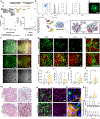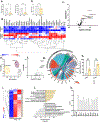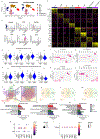Primitive macrophages enable long-term vascularization of human heart-on-a-chip platforms
- PMID: 38908380
- PMCID: PMC11297673
- DOI: 10.1016/j.stem.2024.05.011
Primitive macrophages enable long-term vascularization of human heart-on-a-chip platforms
Abstract
The intricate anatomical structure and high cellular density of the myocardium complicate the bioengineering of perfusable vascular networks within cardiac tissues. In vivo neonatal studies highlight the key role of resident cardiac macrophages in post-injury regeneration and angiogenesis. Here, we integrate human pluripotent stem-cell-derived primitive yolk-sac-like macrophages within vascularized heart-on-chip platforms. Macrophage incorporation profoundly impacted the functionality and perfusability of microvascularized cardiac tissues up to 2 weeks of culture. Macrophages mitigated tissue cytotoxicity and the release of cell-free mitochondrial DNA (mtDNA), while upregulating the secretion of pro-angiogenic, matrix remodeling, and cardioprotective cytokines. Bulk RNA sequencing (RNA-seq) revealed an upregulation of cardiac maturation and angiogenesis genes. Further, single-nuclei RNA sequencing (snRNA-seq) and secretome data suggest that macrophages may prime stromal cells for vascular development by inducing insulin like growth factor binding protein 7 (IGFBP7) and hepatocyte growth factor (HGF) expression. Our results underscore the vital role of primitive macrophages in the long-term vascularization of cardiac tissues, offering insights for therapy and advancing heart-on-a-chip technologies.
Keywords: blood vessels; cardiac tissue; cardiomyocyte; endothelial cells; myocardium; organ-on-a-chip; pluripotent stem cell; primitive macrophages; resident macrophage; vascularization.
Copyright © 2024 Elsevier Inc. All rights reserved.
Conflict of interest statement
Declaration of interests M.R. and Y.Z. are inventors on an issued patent that describes Biowire technology. This patent is licensed to Valo Health. M.R. and Y.Z. receive licensing revenue.
Figures







References
-
- Montgomery M, Zhang B, and Radisic M (2014). Cardiac tissue vascularization: from angiogenesis to microfluidic blood vessels. Journal of cardiovascular pharmacology and therapeutics 19, 382–393. - PubMed
-
- Banerjee I, Yekkala K, Borg TK, and Baudino TA (2006). Dynamic Interactions between Myocytes, Fibroblasts, and Extracellular Matrix. Ann N Y Acad Sci 1080, 76–84. - PubMed
-
- Kuzuya M, and Kinsella JL (1994). Induction of endothelial cell differentiation in vitro by fibroblast-derived soluble factors. Exp Cell Res 215, 310–318. - PubMed
-
- Dick SA, Macklin JA, Nejat S, Momen A, Clemente-Casares X, Althagafi MG, Chen J, Kantores C, Hosseinzadeh S, Aronoff L, et al. (2019). Self-renewing resident cardiac macrophages limit adverse remodeling following myocardial infarction. Nature immunology 20, 29–39. 10.1038/s41590-018-0272-2. - DOI - PMC - PubMed
MeSH terms
Substances
Grants and funding
LinkOut - more resources
Full Text Sources
Miscellaneous

